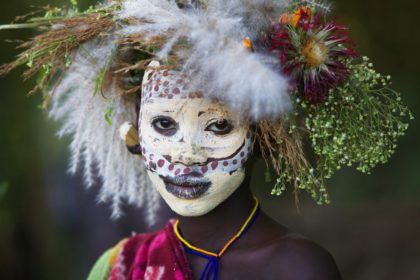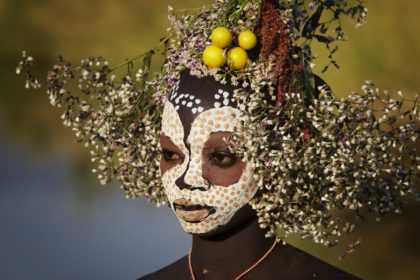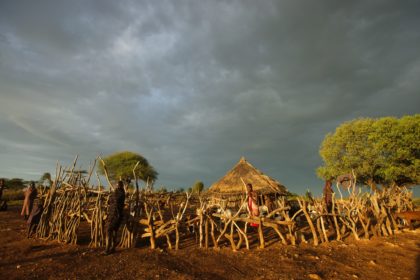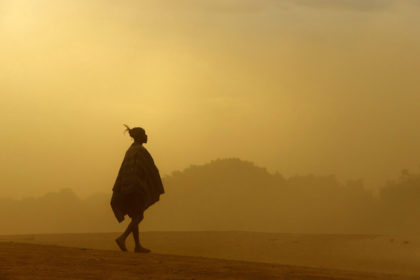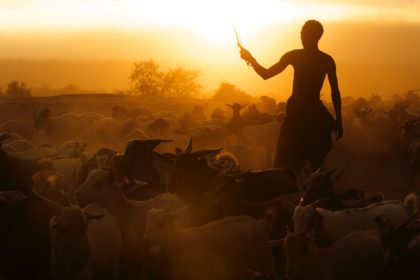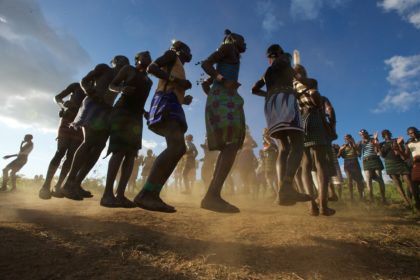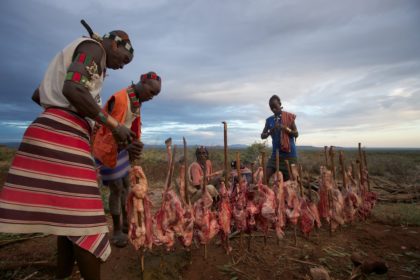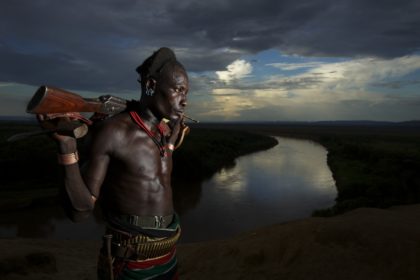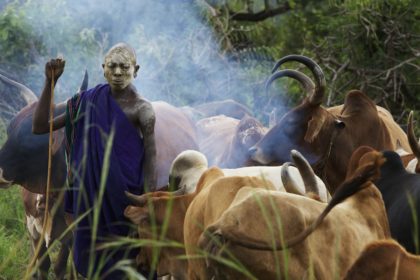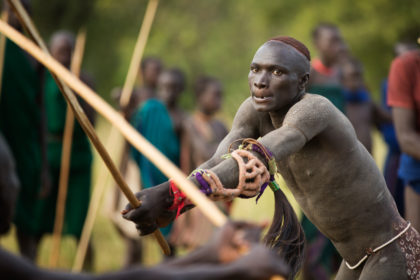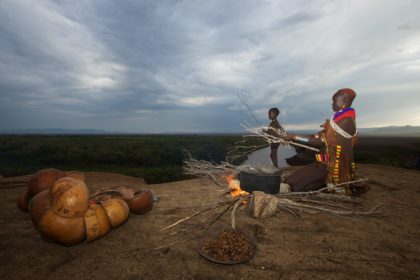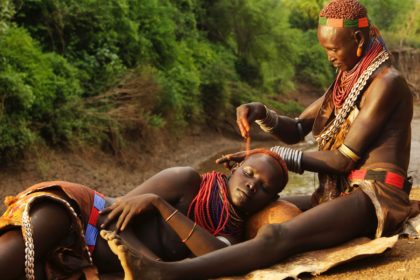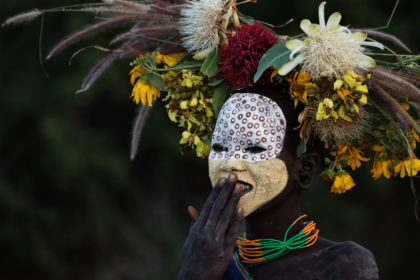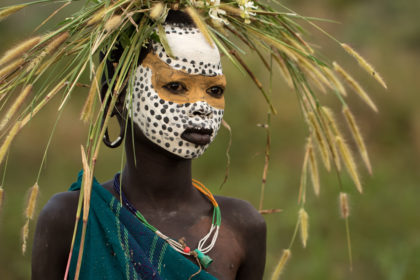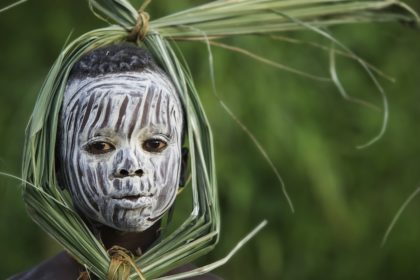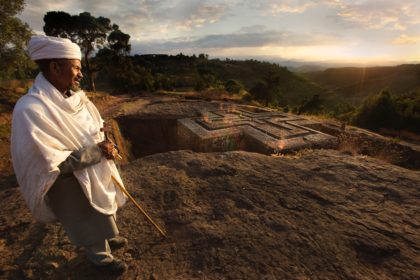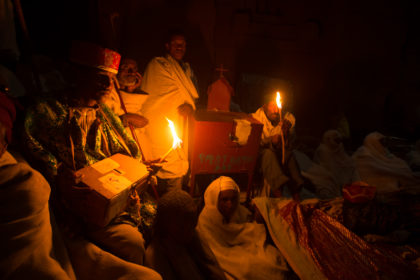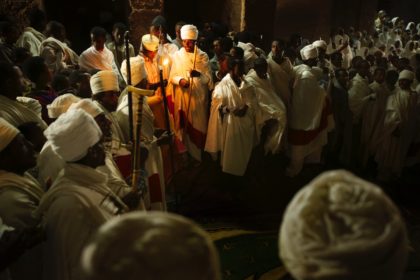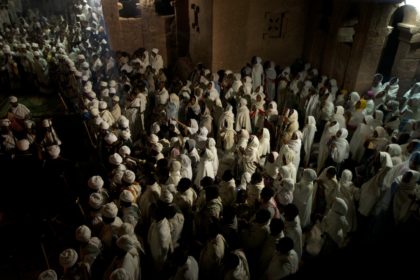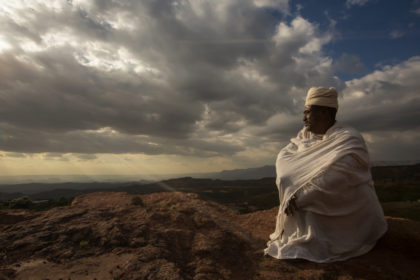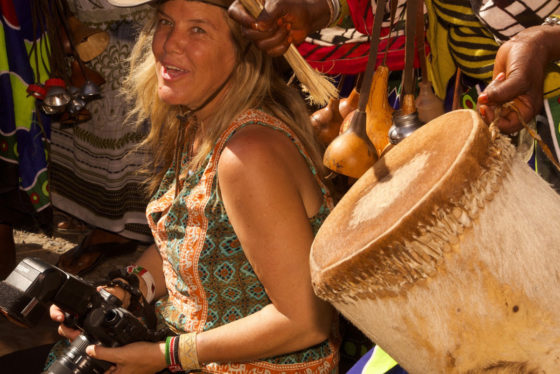January 5-20, 2019
Timed to coincide with the Christmas celebration in Lalibela, held on January 7, this life-enriching photographic adventure takes you from one of the most historical cultures in the North to the exotic tribes in southern Ethiopia’s Omo Valley region.
One of Ethiopia’s holiest cities, Lalibela rests high in the mountains of Lasta and is home to over 1,000 priests who can be found wandering through the ancient dusty town. The famous churches are all intricately carved from the Rock Mountains and are joined by a maze of tunnels and bridges. The walls are adorned with tapestries, the floors are covered in carpets, all of which is lit from high-carved windows where dappling light seeps through.
During this time, thousands of pilgrims come from all over the country, gathering around the ancient dramatic underground churches. In the evenings, the priests move through the churches in a rhythm of faith, chanting in prayer, and lighting hundreds of candles. The high priest, in their fanciest robes, will gather along the walls of St Mary’s church at sunrise on Christmas to perform a lively ceremony. There are no words to describe the ambiance of this experience – a timeless and almost biblical atmosphere. This is when you will fully come to understand this ancient city with a chance to be a part of something extraordinary that dates back hundreds of years.
In stark contrast to the historical ancient city of Lalibela, we will fly from the North directly to the Omo Vally, one of the most exotic and rich tribal regions on the African continent. We will visit tribes on both sides of the Omo river, including spending several days visiting the most ornate tribe; the Suri, also known as the Surma. Not only are the Suri the most striking tribe, they are the most remote tribe in the Omo, making them one of the least photographed, and subsequently one of the most desired tribes to be photographed. Inspired by their environment of wild trees, exotic flowers and lush vegetation, these tribes use the clay soil of bright yellows, startling whites, and rich earth-reds to paint each other’s bodies and make bold decisions about their outfits. In essence, they become a walking body of art; known as a living museum to an anthropologist.
Piper Mackay has been traveling to this region for a decade, developing strong friendships with many of the tribes you will visit. Two special teams will be sent ahead to assemble proper mobile-tented camps, near two separate villages, allowing us to fully immerse ourselves with these tribes, which is rarely offered in an itinerary. You will feel more like friends of the tribe rather than the visitors that stay in the lodge more than an hour away. This will allow you to be in the village at sunrise and sunset and spend quality time in each location. You will not only have the opportunity to photographically document their daily lives, capture stunning portraits, and experience some of their timeless ceremonies, but we will also share coffee, stories, and a meal with many of them, ensuring a life-enriching experience, which leads to more compelling images.
In true expedition style, Piper has left the program with some flexibility to take advantage of any photographic opportunities that may arise. The precise time spent in each village will depend on what activities are taking place and the goals of the group. This is a photographic adventure designed by a photographer for photographers who wish to go out in the world on a life-enriching journey and tell a story that means something to them. This itinerary presents some of the richest photographic opportunities in Africa where you will have the opportunity to use your skills and creative process to do meaningful work while having an unforgettable experience. This trip will appeal to experienced photographers who wish to not only immerse themselves in the creative process, but who also want a more intimate and personal experience with the cultures and tribes visited. At all times during our journey, we need to be mindful of how our presence can impact on the cultures we interact with.
For a more rewarding photographic journey, this trip is limited to a small group of only 7 participants, allowing for a more intimate experience, better group dynamics, and higher quality images. When visiting remote tribal villages, the larger the group becomes, the higher the chances are that your subject will be distracted, another photographer will be shooting over you, or another photographer will show up in your photo’s background.
Itinerary
Jan 5, 2019, Arrive at Addis
Upon your arrival at the Bole international airport in Addis Ababa, Ethiopia, you are met by a member of our ground team and are transferred to the Radisson Blu Hotel via private vehicle. After your long flight(s) you will enjoy a relaxing evening in a modern, luxurious hotel, which is the perfect way to rest up for the amazing journey that lies ahead.
Overnight: Radisson Blu Hotel
Jan 6 -8 2019, Lalibela
We are up early to catch our flight to Lalibela. Upon arrival, you will enjoy a scenic drive up the Lasta Mountains and through the town of Lalibela, where hundreds of pilgrims will be making their way to the churches for the upcoming celebration. Throughout the next few days, we immerse ourselves into this ancient atmosphere, wondering through the hand-carved underground churches where priests roam through the tunnels and passageways, enjoying the fascinating celebration of Christmas. At sunrise on Christmas morning, a colorful procession of priests form a line that snakes from the bottom of the steps to the tops of the churches, creating incredible photographic opportunities.
Overnight: Tuliki Lodge BLD
Jan 9, 2019, Fly to Jinka–
After breakfast, on the way to the airport, we will visit the cave-monastery of Neakuto Leab, which is one of the many highlights in Labibela We will not be rushed to make the morning flight, as we have chartered a private plane to fly directly to the south, one of the most exotic tribal regions in the world. Flying by private charter is not only a luxury, but it avoids relying on two domestic on-time flights connecting through Addis and a full day of travel. We will be able to arrive in time to enjoy the bustle of the town before making the very short drive through the beautiful hills to our lodge overlooking a small river.
Overnight Eco Lodge BLD
Jan 10, 2019, Jinka
Rise early and head through Mago National park to visit the exotic Mursi tribe. The most distinctive characteristic of the Mursi is the lip plate. At around the age of fifteen, a mother or another woman in the settlement typically cuts the girl’s lower lip, and it is held open by a wooden plug until the wound heals. It is then the girl’s decision how far to stretch the lip, which is done by inserting progressively larger plugs over several months and years. This was originally said to be done to disfigure themselves to scare off the slave traders; over time, it became a sign of beauty. One of their distinct ornamentations is the wearing of the warthog tusk that connects to solid metal rings, which is tied to a rope that hangs over their heads. They are also known for their beautiful scarification and body painting. The Mursi are one of the most dramatic tribes to photograph, but also one of the most challenging.
During midday, we will have time to review images from that morning before heading back to another Mursi village to photograph them in the afternoon light.
Overnight Eco Lodge BLD
Jan 11-12, 2019 Turmi
After breakfast, we will head to the heart of the Omo Valley. En route, you will notice the beautiful tribal people living throughout the region. Over the next two days, we will spend quality time with the Hamer and the Daasanach, and possibly the Arbore tribe.
The Hamar women are striking, wearing beautiful colorful beaded skins, ornate necklaces, and metal bangles around their wrists and ankles. Famous for their hairstyle — a crown of long dread-lock braids covered in ocher — the Hamer women are the most decorated of the Omo people. We will hope to get word of a bull jumping ceremony, a rite-of-passage ceremony whereby a young Hamer man passes from boyhood to adulthood.
Cousins to the Turkana tribe in Northern Kenya, the Daasanach, are a semi-nomadic tribe numbering approximately 50,000. Their clans stretch across southern Ethiopia, Sudan, and down into Northern Kenya. They are very tall and slender, wearing red and yellow jewelry, leather headpieces lined with bottle caps, and are known for their unique and ornate hair buns.
Our home base in this area is the Buska Lodge, an oasis in the middle of the stark remote region.
Overnight: Buska lodge BLD
Jan 13-15, 2019, Dus
We will have one last beautiful sunrise visit with the Hammer before we go deeper into the valley along the mighty Omo River and into the territory of the Kara tribe. This will be one of the many highlights of the trip, as we have taken great care to set up a proper private mobile-tented camp in the forested area along the Omo River in Dus, the largest village of the Kara, where you will be immersed in the culture. This will allow you to connect with the people on a deeper level, where you will feel more like a friend and a guest than merely a visitor.
The Kara excel in face and body painting; this is practiced daily in preparation for their dances and ceremonies. They pulverize locally found white chalk, yellow mineral rock, red iron ore, and black charcoal in order to decorate their bodies, often mimicking the spotted plumage of a guinea fowl. The men create highly decorated clay hair buns, which can take up to three days to complete. Their ornate body scarring, where a cut is made with a knife and ash is rubbed into the wound to produce a raised welt, is also a known characteristic of the Kara.
Over the next three days, you will spend quality time in the Kara villages, documenting their daily lives, creating beautiful portraits, joining them in song and dance, watching them herd in the livestock across the dusty plains, joining them for morning coffee, learning about their ancient traditions, and learning about how their world is changing with the pressures of the modern world.
Accommodations: Private mobile tent camp BLD
Jan 16-19, 2019 Kibish
Today we continue our adventurous journey, crossing over the Omo River and through the bush, to the remote homeland of the extremely beautiful and exotic Suri tribe. In the early morning, we will stop en route to visit a Nyangatom village, one of the least visited villages that is most feared by other tribes in the Omo. The women have layers and layers of beads around their neck, and wear the most strikingly-designed leather skirts. Although they have their own language, they also speak the Daasanech language. As we near the town of Kibish, excitement builds when you discover the Suri throughout the landscape in their traditional clothing, going about their daily lives. We will arrive in our private mobile-tented camp along the Kibish river in the late afternoon. As word gets out about our arrival, they will come down to the river and near our camp for a wonderful first introduction and afternoon shoot along the river. We will have four incredible days at this location.
The Suri tribe is known to be one of the most beautiful and ornate tribes in the world, and is thus one of the most desired to photograph. The elaborate body painting and unique flamboyant headpieces, made from natural materials, truly make them a walking body of art. The women still practice one of the most extreme forms of body adornment in the world- wearing large lip plates. The tribe still practices the art of body scarification, created via acacia thorns and razor blades.
The Suri are pastoralist. The men still go off to live in the cattle camps, which are under constant threat as cattle raids are a relentless part of Suri life. The men live their traditional lifestyles drinking the blood and milk of the cow, covering their naked bodies with ash, and giving thanks for their good fortune in song and dance. We will have an opportunity to visit these traditional cattle camps, and it is always the highlight of the trip for participants.
Disputes between rival clans are settled in a Donga, a mass stick-fighting event demonstrating bravery and indispensable courage. This is a very tense, yet incredibly emotional event, where you will witness not only the violence of the fight but also the contrast of the unity of brotherhood. I have never attended a more soulful and deeply purposeful fighting ceremony showing such a deep conviction to ancient tradition. This event could happen at any time, and we will be informed should there be any rumors that one might take place.
These four days will be life-changing, and will be an experience that will go to the core of your soul, leaving you with stories that you will share for decades.
Accommodations: Private mobile tent camp BLD
Jan 20, 2016 Addis
If time allows, we will have one last early morning visit with the Suri before driving to Mizan to catch our private chartered flight back to Addis. This flight is from deep in the southern region where there are no commercial flights available. This will save us from two very long days of driving over some rough roads, and a one-night stay in very local accommodations. Once in Addis, you will be met by our ground team and transported to the Radisson Blu, where you will have a dayroom to rest up and clean up before being transferred to the international airport for your late flights home. Should you prefer to stay overnight in Addis to rest up from your incredible expedition, we will be happy to make these arrangements. Flights should be booked after 10:00 PM. Most international flights depart at 10:00 PM and 1:00 AM.
Is this trip for you?
This adventurous photographic experience was created for passionate photographers who want to visit some of the most beautiful tribes on the African continent. The itinerary was designed to give you the best opportunities to produce high-quality images. Therefore, we will rise early in the morning for the best light; a few mornings we rise well before sunrise. We will push hard to maximize every photographic opportunity, which means some long days, but you should go at your own pace. These tribes live in remote areas, so there will be driving on dirt roads, but in comfortable air-conditioned 4X4 utility vehicles. If we get lucky, we will be invited to a special event that may require walking; however, a guide can be hired to assist you with your gear.
This photographic experience was created for photographers with a good working knowledge of their equipment, who fully understand the basics of photography, shutter speed, aperture, iso, exposure and how they relate to each other. Having previous experience photographing indigenous cultures will be beneficial, as this can be a more challenging experience. Although, this is NOT a workshop to teach you techniques, there will be a lot of discussion on photography and informal instruction throughout the trip. Piper is always available to assist you with your vision and for any question you may have.
While our trip is designed around producing high-quality images, we believe our visit should be sensitive, respectful, and beneficial to the communities we visit. We build time into our itinerary to interact with the local people that will lead to a richer experience, rather than just racing from location to location and charging in with camera in hand. It is a privilege to visit these unique tribal areas, and we want to make sure it is a positive experience for them. We also believe in empowering the local communities to look after themselves, and we feel the best way to do this is economically. We work with a small successful, fully licensed local operator, and we hire local guides in every area we visit. Our local partners are key to what we do, and these relationships have been built up over many years, many becoming personal friends. Our visit will generate income in the local areas we visit.
Important Details
The Cost
The cost of this incredible photography adventure is $10,895.00 per person. The price is based on double occupancy;
Single room Premium is $1,495, (if available, as single rooms are limited)
If a solo guest is unwilling to share and requests single accommodations upon registration, then a single supplement will be charged. If you are a solo guest, who will share accommodations, we will do our best to match you with another guest of the same gender. If we cannot match you with another solo guest of the same gender, then the single supplement will be charged, up to, but not exceeding the fee of the single supplement. In this case, whenever possible, we will try to discount the single supplement up to 40%.
A USD $2,500 non-refundable deposit is due at the time of registration to secure your spot. You may purchase travel insurance that will refund your deposit if cancel your trip.
Payment Terms
- USD $2,500.00 non-refundable deposit to confirm your place on this strip
- 2nd payment of USD $3,500.00 is due June 5, 2018
- Final payment/balance is due October 5, 2018
- We highly recommend trip and cancellation insurance.
Included in the trip
- All in-country travel in 4X4 Landrover vehicles and a nice tourist van in Lalibela
- All accommodation, as specified on the itinerary.
- All meals as listed on the itinerary. B=Breakfast, L=Lunch, D=Dinner, beginning with Breakfast on January 6th through Lunch on January 20th
- Gratuities for local guides, porters, lodges, and camps.
- Drinks- coffee, soda, beer, wine (if sold by the glass) and bottled water are included with lunch and dinner
- Laundry services are included in the mobile tent camps (Dus and Kibish) only and available at the lodges for an extra fee.
- All entrance fees to villages and village activities as listed on the itinerary and in the included activities.
- Airport facilitation, meeting & greeting, private transfers upon arrival and departure.
- One In-country commercial/Domestic fight as stated in the itinerary.
- Two In-country private charter flights as stated in the itinerary.
- VAT and local taxes.
- All activities listed as included.
- One main, English speaking guide
- Local guide in Lalibela.
What’s NOT Included
- International airfare and/or between your home and Addis Abba
- Visas
- Travel Insurance
- Personal purchases (including shopping, spirits, laundry, telephone calls etc.)
- Gratuities for our main guide and drivers
- Optional extra activities not included on the itinerary
- Extra photo fees
- Pre- and Post- expeditions tours
- Meals or accommodations before or after the expedition (except as noted in the detailed itinerary)
- Meals and beverages on the day of arrival, this is considered a travel day

